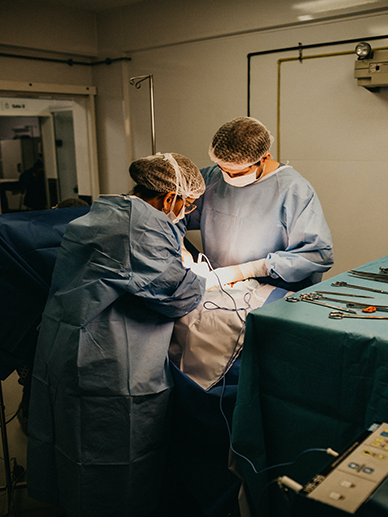Robotic-assisted surgery enables you to receive sophisticated treatments with less downtime. It uses specialized technology to deliver precise care, even in hard-to-reach areas. Robotic surgery treats conditions affecting your heart, digestive system, bladder, prostate, and more.
What is robotic surgery?
Robotic surgery is a type of minimally invasive surgery that uses specialized robotic systems to assist the surgeon during the operation. These systems consist of a console where the surgeon sits and controls the robotic arms, which are equipped with surgical instruments that can be inserted into the patient’s body through small incisions. The surgeon uses hand and foot controls to manipulate the robotic arms, which have a greater range of motion and precision than human hands. The robotic system also includes a high-definition camera that provides the surgeon with a 3D view of the surgical field. Robotic surgery is used in a variety of procedures, including urologic, gynecologic, cardiac, and general surgeries. It offers several potential benefits over traditional open surgery, such as smaller incisions, less pain and scarring, and faster recovery times.
Who performs robotic surgery?
Robotic surgery is typically performed by a specially trained surgeon who has expertise in using the robotic surgical system. The surgeon controls the robotic arms and instruments from a console near the operating table, and the robot translates their hand movements into precise movements of the instruments inside the patient’s body. While the robot is performing some aspects of the procedure, the surgeon is still fully in charge of the operation and makes all the important decisions about how to proceed.
What types of robotic-assisted surgery are available?
Robotic surgical procedure is suitable for plenty of kinds of procedures. It’s often utilized by urologists, gynecologic surgeons, preferred surgeons, cardiothoracic surgeons, and colorectal surgeons.
Types of robotic procedures currently available include:
There are several types of robotic surgery available today, including:
- Robotic-assisted laparoscopic surgery: This type of surgery uses a robot to assist the surgeon in performing minimally invasive procedures through small incisions.
- Robotic-assisted cardiac surgery: This type of surgery is used for complex heart surgeries that require high precision and accuracy.
- Robotic-assisted colorectal surgery: This type of surgery is used for colorectal cancer or other diseases that affect the colon or rectum.
- Robotic-assisted gynecologic surgery: This type of surgery is used for procedures such as hysterectomy, myomectomy, and endometriosis treatment.
- Robotic-assisted urologic surgery: This type of surgery is used for procedures such as prostatectomy, cystectomy, and nephrectomy.
- Robotic-assisted orthopedic surgery: This type of surgery is used for joint replacement procedures, such as knee and hip replacements.
- The specific type of robotic surgery used depends on the patient’s condition and the surgeon’s expertise.
How is robotic surgery different from traditional, open surgery?
Robotic surgery, also known as robot-assisted surgery, is a type of minimally invasive surgery that uses robotic systems to assist surgeons in performing surgical procedures. Traditional open surgery involves making a large incision to access the surgical site, while in robotic surgery, small incisions are made, and the surgeon controls the robotic arms to perform the procedure.
One of the main advantages of robotic surgery over traditional open surgery is that it allows for greater precision and control. The robotic arms used in the procedure can move with greater dexterity than human hands, allowing for more precise movements in delicate areas. Additionally, robotic surgery often involves less blood loss, smaller incisions, less pain, and shorter recovery times than traditional open surgery.
However, robotic surgery may not be appropriate or effective for all types of surgical procedures. It is important to discuss the risks and benefits of robotic surgery versus other types of surgical approaches with your healthcare provider.
What happens during robotic surgery?
- An assistant stays next to you to help the surgeon by changing the instruments when needed.
- First, your general practitioner makes one or greater small incisions.
- Through those incisions, your general practitioner locations ports (skinny tubes). The robotic is connected to those ports and gadgets are then positioned via them.
- A lengthy skinny digital digicam (endoscope) is positioned via one of the ports. The digital digicam affords high-definition pictures in three-D at some stage in the surgery.
- Surgical gadgets are positioned via the opposite ports, which lets the general practitioner to the operation.
- Your surgeon controls the robot arm at the same time as sitting at a console some feet from you.
- An assistant remains safteryou to assist the general practitioner via way of means of converting the gadgets whilst needed.
What are the benefits of robotic surgery?
With robot-assisted surgery, you may experience:
Less Pain and Scarring: Robotic surgery uses small incisions that are less painful than the larger incisions made during open surgery. This also results in smaller scars.
Reduced Blood Loss: The robotic system’s precision and control may lead to less blood loss during surgery.
Faster Recovery Time: Patients who undergo robotic surgery may experience a quicker return to normal activities due to the smaller incisions and less trauma to the body.
More Precise Surgery: The robotic system allows for precise movements of surgical instruments, providing greater accuracy and control than traditional surgery.
Enhanced Visualization: Surgeons can view the surgical site in high definition with 3D imaging, providing better visualization of the area being operated on.
Reduced Risk of Complications: The smaller incisions and more precise surgery may result in a reduced risk of complications such as infection and bleeding.
Shorter Hospital Stay: Patients who undergo robotic surgery may have a shorter hospital stay compared to traditional surgery.
Overall, robotic surgery can provide several benefits for patients, including improved outcomes, reduced complications, and faster recovery times.
What are the disadvantages of robotic surgery?
Robotic surveying, like any technology, has its own set of disadvantages. Here are some of them:
Cost: Robotic surveying equipment can be expensive to purchase and maintain, which may make it less accessible to smaller companies or individuals.
Limited functionality: While robotic surveying equipment is highly advanced, it can still be limited in certain situations. For example, it may not be able to perform well in heavily wooded areas or on unstable terrain.
Dependence on technology: Surveyors who rely too heavily on technology may become complacent and overlook important details that could affect the accuracy of their work. Additionally, if the equipment malfunctions or breaks down, it can disrupt the entire surveying process.
Lack of personal touch: Robotic surveying removes the human element from the process, which can make it more difficult to establish and maintain relationships with clients.
Data overload: Robotic surveying equipment generates vast amounts of data, which can be overwhelming to sort through and analyze. This can be especially challenging for those who are not familiar with data analysis software.
What can I expect when I come home from the hospital?
You’ll receive at-home care instructions that are specific to the procedure you had. They typically include:
- Take it easy for a few days or however long your surgeon recommends.
- Resuming everyday activities gradually. If you’re not on prescription pain medications, you can start driving when you’re ready.
- Not lifting anything heavy until you follow up with your doctor.
- Watching for signs of infection near your incision site.
- Taking medications for pain or constipation.
When should I contact my healthcare provider after having robotic-assisted surgery?
Your care should include follow-up appointments to track your recovery. Contact your healthcare provider immediately if you experience:
- Blood-soaked dressings, which can be a sign of excessive bleeding.
- Infections that cause a fever or yellowish discharge from your incision.
- Pain that doesn’t respond to medications.
- Signs of blood clots, such as abnormal swelling in your groin or lower leg.
- Vomiting and not being able to keep fluids down.
Additional Details
What are common myths about robotic surgery?
Myth: The robot performs the procedure.
Reality: Robotic surgical technology can’t move on its own. Surgeons are in control at all times. There are safety mechanisms in place to ensure the robot doesn’t move without the surgeon controlling it.
Myth: Robots are so precise that I don’t have to worry about complications.
Reality: Robotic-assisted surgery lowers the risk of certain complications. But they’re still possible.
Myth: Open surgery is better because the surgeon has a direct view of the surgical area.
Reality: With robot-assisted technology, surgeons have an enhanced view. A camera provides real-time, high-resolution, magnified images with 3D capabilities.
Robotic surgery is a rapidly growing field that has the potential to revolutionize the way surgeries are performed. While it offers many benefits such as improved precision, smaller incisions, and reduced recovery time, there are also some challenges, including the high cost of equipment and training, as well as concerns about safety and efficacy.
Overall, robotic surgery holds great promise for improving patient outcomes, but it is important to continue to evaluate its effectiveness and ensure that it is being used appropriately and safely. As technology continues to advance and more research is conducted, we will likely see even more widespread adoption of robotic surgical techniques in the future.
References:



Add a Comment